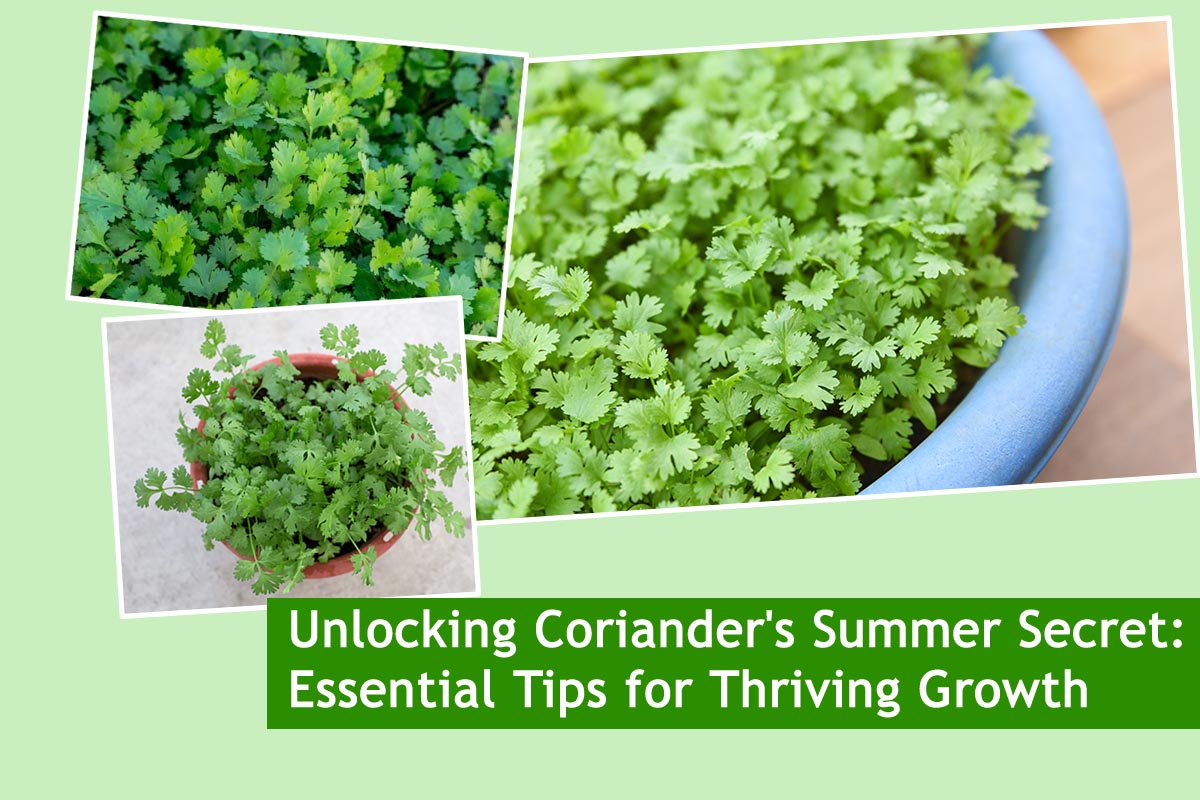
Unlocking Coriander’s Summer Secret: Essential Tips for Thriving Growth
Coriander, with its distinctive aroma and flavorful leaves, is a staple herb in many cuisines worldwide. While it thrives in cooler temperatures, growing coriander in the summer can be a challenge for many gardeners. However, with the right techniques and care, you can unlock the secret to successful coriander cultivation even in the heat of summer. In this guide, we’ll explore essential tips to help your coriander plants thrive during the warmer months.
Understanding Coriander:
Before diving into tips for summer coriander cultivation, let’s briefly understand this herb. Coriander (Coriandrum sativum) is a member of the Apiaceae family and is grown for its aromatic leaves and seeds. It’s commonly used in various culinary dishes, from curries and salads to soups and sauces. Coriander prefers cool temperatures and can bolt, or go to seed prematurely, in hot weather, making it challenging to grow in the summer months.

Choose the Right Variety:
When planning to grow coriander in the summer, selecting the right variety is crucial. Look for heat-tolerant varieties specifically bred for summer cultivation. These varieties are more resilient to high temperatures and are less likely to bolt quickly. Some heat-tolerant coriander varieties include ‘Slow Bolt’ and ‘Leisure.’
Also Read This : Mastering the Art of Watering: Keeping Your Garden Green Year-Round
Optimal Planting Time:
To maximize coriander’s growth during the summer, timing is essential. Plant coriander seeds or seedlings in early summer, preferably when temperatures are still moderate. Sow seeds directly into the soil or containers, ensuring they receive adequate sunlight and are planted at the correct depth, typically around ¼ to ½ inch deep.
Provide Adequate Sunlight:
While coriander prefers cooler conditions, it still requires ample sunlight to grow and thrive. Ensure your coriander plants receive at least 4-6 hours of sunlight per day, preferably during the cooler morning hours. If you’re gardening in a particularly hot climate, consider providing partial shade during the hottest part of the day to prevent stress on the plants.
Also Read This : 7 Bedroom-Friendly Plants to Transform Your Space
Watering:
Proper watering is crucial for summer coriander cultivation. Keep the soil consistently moist but not waterlogged. Water your coriander plants deeply, allowing the soil to dry slightly between watering sessions. Mulching around the base of the plants can help retain soil moisture and regulate temperature, particularly during hot weather.
Fertilization:
During the summer growing season, coriander plants benefit from regular fertilization to support healthy growth. Apply a balanced fertilizer every 4-6 weeks or use a slow-release fertilizer at the beginning of the season. Avoid over-fertilizing, as excessive nitrogen can promote lush foliage growth at the expense of flavor.
Also Read This : The Science Behind Planting Tomatoes with Coffee Grounds for Rapid Growth
Proper Spacing:
When planting coriander in your garden or containers, ensure proper spacing between plants to allow for adequate airflow. Crowded plants are more susceptible to fungal diseases and may compete for nutrients and sunlight. Space coriander plants approximately 6-8 inches apart in rows or containers.

Prevent Bolting:
Bolting is a common issue with coriander, especially in hot weather. To prevent premature bolting, keep the soil consistently moist and avoid letting the plants dry out. Harvest the leaves regularly to encourage bushier growth and delay flowering. Additionally, consider providing afternoon shade or using row covers to moderate temperatures and reduce stress on the plants.
Also Read This : Unveiling the Best Liquid Fertilizer for Thriving Indoor Plants
Companion Planting:
Companion planting can benefit coriander by attracting beneficial insects and repelling pests. Planting coriander alongside companion plants such as dill, basil, and chervil can help improve overall plant health and deter common pests like aphids and spider mites.
Harvesting:
Harvesting coriander leaves regularly promotes continuous growth and prevents the plant from bolting prematurely. Begin harvesting when the plants reach 6-8 inches in height, taking care not to remove more than one-third of the plant at a time. Use sharp scissors or pruning shears to cut the outer leaves, leaving the center of the plant intact for regrowth.
Also Read This : Troubleshooting Yellowing Hibiscus Buds: Essential Tips for a Blossoming Garden
Saving Seeds:
If you allow some coriander plants to bolt and go to seed, you can harvest the seeds for future planting. Allow the seeds to dry on the plant before collecting them. Store the seeds in a cool, dry place in an airtight container for long-term storage. Alternatively, you can use fresh coriander seeds in cooking or to plant in the next growing season.
Also Read This : Unlocking the Secret to Keeping Your Curry Leaf Plant Green Year-Round: One Simple Addition
Growing coriander in the summer may pose challenges, but with the right techniques and care, you can enjoy a bountiful harvest of this flavorful herb. By choosing heat-tolerant varieties, providing adequate sunlight and water, preventing bolting, and practicing proper care and maintenance, you can unlock the secret to successful coriander cultivation even in the heat of summer. With these essential tips, you’ll be well on your way to growing healthy and flavorful coriander plants all season long.




